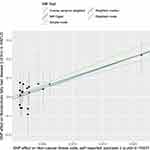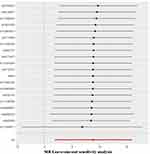Back to Journals » Clinical, Cosmetic and Investigational Dermatology » Volume 16
Association Between Psoriasis and Non-Alcoholic Fatty Liver Disease: A Two-Sample Mendelian Randomization Study
Authors Li H, Su J, Zhu M, Zhu Y, Zhu S
Received 7 September 2023
Accepted for publication 27 October 2023
Published 14 November 2023 Volume 2023:16 Pages 3291—3294
DOI https://doi.org/10.2147/CCID.S439115
Checked for plagiarism Yes
Review by Single anonymous peer review
Peer reviewer comments 2
Editor who approved publication: Dr Anne-Claire Fougerousse
Hong Li,1,2 Juan Su,3 Mingfang Zhu,4 Yaqi Zhu,1,2 Shilin Zhu1
1Department of Nursing, The Second Affiliated Hospital, Hunan University of Chinese Medicine, Changsha, People’s Republic of China; 2School of Nursing, Hunan University of Chinese Medicine, Changsha, People’s Republic of China; 3Department of Dermatology, Xiangya Hospital, Central South University, Changsha, People’s Republic of China; 4Department of Dermatology, The Second Affiliated Hospital, Hunan University of Chinese Medicine, Changsha, People’s Republic of China
Correspondence: Shilin Zhu, Email [email protected]
Psoriasis is an immune-mediated inflammatory skin disease characterised by painful or itchy scaly erythematous plaques, and its clinical phenotypes include vulgaris, pustular, erythrodermic and arthropathic forms. Psoriasis is associated with many co-morbidities such as metabolic syndrome, diabetes and non-alcoholic fatty liver disease (NAFLD).1 Previous studies have reported a prevalence of 47% for NAFLD in patients with psoriasis.2 Observational studies have found that psoriasis is associated with NAFLD,3 some GWAS studies have also found that NAFLD may not be a risk factor for psoriasis.4 However, the exact physiological mechanisms behind the observed results are unknown and may be related to the high prevalence of obesity and metabolic syndrome in this patient population.1 In addition, the occurrence of NAFLD in patients with psoriasis may be related to the existence of a common pathogenesis for both diseases, which are both affected by the pro-inflammatory T-helper (Th)17 axis.5 Therefore, the causal relationship between psoriasis and NAFLD is still unclear. Mendelian randomization (MR) is an approach using single-nucleotide polymorphism (SNP) instrumental variables (IVs) based on Genome-wide association studies (GWAS); it can effectively control the confounding bias and address gaps in observational. In MR studies, IVs were randomized and used as IVs of exposure to simulate real-world randomized controlled studies, thereby exploring the relationship between exposures and outcome variables.6 Therefore, we used two-sample MR to explore the causal relationship between psoriasis and NAFLD.
GWAS data regarding psoriasis and NAFLD were obtained from a public website (https://gwas.mrcieu.ac.uk/). We conducted GWAS analyses (https://gwas.mrcieu.ac.uk/datasets/ukb-b-10537/) on 5314 patients with psoriasis and randomly selected 457,619 patients without psoriasis (ie, the control group) as well as on 894 patients with NAFLD and randomly selected 217,898 patients with alcoholic fatty liver (ie, the control group) (https://gwas.mrcieu.ac.uk/datasets/finn-b-NAFLD/). After releasing linkage disequilibrium, a total of 20 SNPs were included in our study as instrumental variables. The R software (version 4.0.4) and Two Sample MR (version 0.5.7) were used for the analyses. The two-sample MR analyses were conducted using inverse variance weighting method, and pleiotropy test was performed using the MR-Egger method. The unidirectionality and reliability of results were evaluated using reverse MR and leave-one-out method. For all the analyses, the significance threshold was set at P <0.05.
The inverse variance weighting analysis (βIVW=8.98, P=0.01, Figure 1) and MR-Egger test (β=11.09, P=0.03) showed that the genetic risk of psoriasis was positively associated with the increase in the relative risk of NAFLD. However, bidirectional association evaluation showed that genetic predisposition of NAFLD did not increase the risk for psoriasis (P=0.70). To ensure that instrumental variables affect patients’ outcome via risk factors only, we used the MR-Egger method for horizontal pleiotropy test, which indicated no significant pleiotropy in the IVW analysis (P=0.50). Finally, the leave-one-out sensitivity analysis was used to determine the influence of each SNP site on the overall causal relationship, which suggested that our MR results were stable except rs12189871 (Figure 2).
 |
Figure 1 Two-sample Mendelian randomization analysis of the effect of the psoriasis on NAFLD using different methods. |
 |
Figure 2 Leave-one-out sensitivity analysis of the effect of psoriasis on NAFLD. |
The present study found that the genetic risk of psoriasis might have a unidirectional causal effect on NAFLD. This finding suggests the need for clinicians to manage the disease holistically in patients with psoriasis, especially considering patients with hepatotoxic medications and psoriasis combined with metabolic syndrome, and to choose a personalised treatment strategy that is helpful for multiple conditions to meet the patient’s therapeutic needs and improve quality of life.7 Early attention should also be paid to the comorbidity profile of patients with psoriasis, with early screening of liver function to prevent and manage other comorbidities. The strengths of this study include the use of an MR framework for causal inference, which allows for more efficient unbiased estimation of associations, and the large sample size and experimental design, which is closer to randomised matching than observational studies. However, our study has the following limitations: the GWAS data used in this study were mainly from European populations, which may limit the applicability of the findings to other populations; secondly, the causal effect of psoriasis and NAFLD was only analysed in this study through a Mendelian randomisation study, whereas the pathogenic mechanisms of psoriasis on NAFLD need to be further investigated.
Data Sharing Statement
All supporting data in the study are publicly available from GWAS database (https://gwas.mrcieu.ac.uk/).
Ethics Statement
Ethics approval and informed consent were not required as the data were publicly available.
Author Contributions
All authors made a significant contribution to the work reported, whether that is in the conception, study design, execution, acquisition of data, analysis and interpretation, or in all these areas; took part in drafting, revising or critically reviewing the article; gave final approval of the version to be published; have agreed on the journal to which the article has been submitted; and agree to be accountable for all aspects of the work.
Funding
This work was supported by the Chinese Medicine Research Program Project of Hunan Province (Grant number: D2022046).
Disclosure
The authors declare no competing interests in this work.
References
1. Wenk KS, Arrington KC, Ehrlich A. Psoriasis and non-alcoholic fatty liver disease. J Eur Acad Dermatol Venereol. 2011;25(4):383–391. doi:10.1111/j.1468-3083.2010.03841.x
2. Gisondi P, Targher G, Zoppini G, Girolomoni G. Non-alcoholic fatty liver disease in patients with chronic plaque psoriasis. J Hepatol. 2009;51(4):758–764. doi:10.1016/j.jhep.2009.04.020
3. Ruan Z, Lu T, Chen Y, et al. Association between psoriasis and nonalcoholic fatty liver disease among outpatient US adults. JAMA Dermatol. 2022;158(7):745–753. doi:10.1001/jamadermatol.2022.1609
4. Naslund-Koch C, Bojesen SE, Gluud LL, Skov L, Vedel-Krogh S. Non-alcoholic fatty liver disease is not a causal risk factor for psoriasis: a Mendelian randomization study of 108,835 individuals. Front Immunol. 2022;13:1022460. doi:10.3389/fimmu.2022.1022460
5. Gau SY, Huang KH, Lee CH, Kuan YH, Tsai TH, Lee CY. Bidirectional association between psoriasis and nonalcoholic fatty liver disease: real-world evidence from two longitudinal cohort studies. Front Immunol. 2022;13:840106. doi:10.3389/fimmu.2022.840106
6. Gu X, Chen X, Shen M. Association of psoriasis with risk of COVID-19: a 2-sample Mendelian randomization study. J Am Acad Dermatol. 2022;87(3):715–717. doi:10.1016/j.jaad.2022.01.048
7. Camela E, Potestio L, Fabbrocini G, Pallotta S, Megna M. The holistic approach to psoriasis patients with comorbidities: the role of investigational drugs. Expert Opin Investig Drugs. 2023;32(6):537–552. doi:10.1080/13543784.2023.2219387
 © 2023 The Author(s). This work is published and licensed by Dove Medical Press Limited. The full terms of this license are available at https://www.dovepress.com/terms.php and incorporate the Creative Commons Attribution - Non Commercial (unported, v3.0) License.
By accessing the work you hereby accept the Terms. Non-commercial uses of the work are permitted without any further permission from Dove Medical Press Limited, provided the work is properly attributed. For permission for commercial use of this work, please see paragraphs 4.2 and 5 of our Terms.
© 2023 The Author(s). This work is published and licensed by Dove Medical Press Limited. The full terms of this license are available at https://www.dovepress.com/terms.php and incorporate the Creative Commons Attribution - Non Commercial (unported, v3.0) License.
By accessing the work you hereby accept the Terms. Non-commercial uses of the work are permitted without any further permission from Dove Medical Press Limited, provided the work is properly attributed. For permission for commercial use of this work, please see paragraphs 4.2 and 5 of our Terms.
